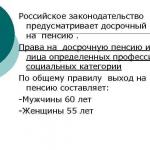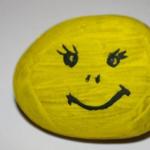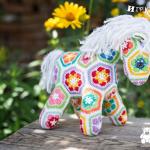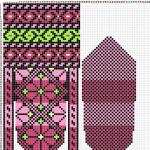Manual buttonholes. Hand sewing buttonholes
Finished loops are cut before they are stitched. They are usually made on double fabric and through products. Fabric that frays easily can be sealed on the back with a fusible seal, and cut edges can be hemmed before buttonhole stitching is done. Usually, for sewing loops, use a single thread, standard for sewing light fabrics. Special threads are used for sewing buttonholes on medium-weight and thick fabrics.
Let's learn how to make a buttonhole by hand.
Types of hand loops
Ends - round and square
These loops are always placed horizontally on the product. The buttoned button sits in the rounded end of the loop, which supports it, makes it easier to fasten and unfasten and prevents the slit from tearing.

Square ends
Such loops are placed vertically. When the product is buttoned, the button sits slightly below the buttonhole. Loops are made mainly on shirts and products home clothes and linen.

Rounded ends
This is how vertical loops with a cut through which a cord or ribbon passes are processed. The width of the loop is determined by the width of the ribbon or the volume of the cord. Loops are used for outerwear from dense fabrics.

Keyhole
A loop for a horizontal position, with a small hole at the rounded end and with stitching, which is done over a thin cord. The hole allows you to use any buttons with a large voluminous stem.
How to make a buttonhole by hand?
On front slits, horizontal loops cover the center line of the garment by 3mm. Below is a method for processing a loop with one rounded end and one square end. The rounded end is designed to hold the button under tension. Vertical loops are made in the same way, only both ends are rounded or both ends are square.

Mark the line of loops. Use a short 2mm stitch on thin fabrics and a longer stitch on thick ones. Sew a rectangle directly under the stitch length on the outside and around the buttonhole marking (top).

Cut the loops in the center of the markings. Serge the raw edges to avoid fraying. Working along the right side with the rounded end of the loop on the left, secure the end of the thread with small stitches in the opposite direction at the bottom corner

Sew a buttonhole stitch along one long edge. Insert the needle from bottom to top, onto the front side of the product (at the top). Pass the thread behind the eye of the needle and under the tip. Pull the thread so that the resulting knot covers the cut edge.

Place stitches very close together to cover the raw edge. Sew five or seven slightly longer stitches around the end of the loop (top). The center stitch should be flush with the cut edges.

Sew a buttonhole stitch along the other edge. Sew through the knot of the first stitch, removing the needle under the last stitch. Make a strip of three or four long stitches to work the rectangle edge of the buttonhole (above).

With the tip of the needle pointing toward the loop, starting at one end, use a loop stitch to sew across the long stitches (at the top), catching the fabric of the piece at the bottom. The stitches should form an even row of knots.
There are nuances in the product that are invisible to the average person, by which the craftsman can quickly and accurately determine the class of tailoring. These include sleeve caps, stitching, and fit. But one of the most important points are undoubtedly loops, including a loop with an eye. And it is hinges that fashion houses pay attention to Special attention. Despite the fact that a slotted buttonhole with an eye can be made using sewing equipment, luxury ateliers make such buttonholes on expensive coats and jackets exclusively by hand. And this operation is trusted only to a master with extensive experience.
Let's master this necessary sewing operation and learn how to make exclusive slotted loops with an eye, because your products will only benefit from this!
Welted loop with eye - master class
There are many various techniques When performing such loops, each master has his own tricks and secrets. We will consider the most, in our opinion, nice option loops - with a raised chain stitch.
To perform this sewing operation we will need:
- Madeira Aerofil thread No. 35. You can also use any other strong thread No. 30 or 35; special strong silk threads are also used. Threads are selected to match the fabric of the product or contrasting ones, depending on the designer’s idea. For clarity, we use contrasting yellow threads.
- A piece of wax. Waxed thread is less “shaggy” and tangles less, so the thread for making loops is pre-treated with a piece of wax.
- Metal ruler for marking loops.
- Rectangular ruler for marking loops.
- Punch.
- Awl.
- Snacks.
- Loop ripper. In case of an error, a seam ripper will come in very handy.
Rice. 1. Tool for making a buttonhole with an eye
Step back 2 cm from the edge of the product and draw an edge line along which the loops will be made. Set aside the width of the finished loop from the line at a right angle (in our case it is 2.5 cm). Place the loops at the same distance from each other. For coats it is 11-12 cm, for jackets and men's jackets 8-9 cm.
Rice. 2. Marking the edge of the loops
Rice. 3. Marking loops
Lay fixing snares along the side. Also lay fixing snares around each loop so that they do not intersect with the loop markings. Measure a thread about 60 cm long, wire it by pressing the thread tightly to a piece of wax and pulling it along the wax.
Rice. 4. Fixing snares around the loop
Rice. 5. Waxing thread
A spacer thread is used to lift the loop. To prepare it, bend the waxed thread in half and start twisting it on both sides in different directions (Fig. 6). When the threads are tightly twisted, bend them in half again - the threads themselves will twist together. We received a spacer thread consisting of 4 threads twisted together (Fig. 7).
Place the punch on the edge of the loop closest to the hem, and on the wrong side place a piece of fabric folded several times. Punch the “eye” of the future loop (Fig. 8). Using snips or straight scissors, cut the loop along the markings (Fig. 9).
Rice. 8. Punching a peephole using a punch
Rice. 9. Cutting a loop
Secure the end of the prepared interlining thread with a pin and lay it along the loop (Fig. 10). Treat the thread for making the loop with wax, thread it into the needle, make a knot and stick it on the back side of the product at a distance of 2 cm from the edge of the loop (Fig. 11) (after completing the work, the thread is cut and removed).
Rice. 10. Laying the interlining thread
Rice. 11. Starting work from the back of the product
Bring the needle to the outside at the edge of the loop, at a distance of 2 mm from the cut. Wrap the needle around the spacer thread and insert the needle from the back side, bringing it out to the outside close to the first puncture (Fig. 13). Try to make punctures at the same distance from the incision - about 2 mm.
To get a beautiful stitch at the top of the loop, the thread must twist (see Fig. 15). To do this, insert the needle into the loop under the bottom thread and pull it up.
Pull the thread up so that the stitch is on top. Continue stitching as shown in fig. 13-16.
Rice. 16. The thread is pulled up

Hand-buttoning is a sign of skill.
Renata: I once worked in a government tailor shop. There, absolutely all the loops are made only by hand. I needed to make buttonholes in a coat where the lining was made of velvet, and the buttonhole machine completely refused to make buttonholes. A super master made them for me. To begin with, the thread for the loop was necessarily treated with wax for strength, then the fabric was cut with a special device in the form of a loop with an eye, then a stitch was made around the cut - this was like a frame for the loop, and then the loop was overcast. Double thread, of course. The hinges looked amazing! The coat has long since fallen into disrepair, but it’s a shame to throw it away because of the loops - they are a work of art. At least cut it out and frame it on the wall.
When I sew on buttons, I rub the threads with wax - the button lasts longer.
MPFH: I will add about wax (waxing)... For convenience, you need to cut ordinary threads to the distance that you usually use for your handmade. If there is no wax, you can replace it with a regular candle. You need to “pull” these cut threads through the candle twice, then lay them completely between two layers of material and iron them. After such waxing, the threads cannot be separated, only with scissors. Then wind them on an unnecessary reel.
I noticed that sometimes after ironing the threads, traces of the color of the threads remain on the material, which means some threads were dyed poorly, so waxing to some extent protects against shedding.
Handy girl: Everyone has their own cockroaches. I have these cockroaches - loops.
If you process a loop on a machine (no matter at home or at work), then first the loop is overcast, and then the fabric is cut (or cut) between the two edges of the loop. In this case, as a rule, either immediately or a little later, the fabric begins to fringe slightly. I don't really like it.
Please note that when made by machine, the front side of the loop looks much neater than the back side, due to the fact that the tension of the upper thread is weaker. If the model assumes that the backside of the loop will be fully demonstrated (a loop on a collar and top loops on a blouse, etc.), then you must agree that the appearance of the loop from the back is also important.
I first cut the fabric and only then overcast it. In this case, all the edges of the loops are immediately hidden under the threads, the edges of the loops look neat. And in this case, the front side looks more beautiful than the back, but the difference is not so striking.
Depending on the type of fabric, the thickness and type of threads vary (single or double, silk or cotton). It is very important to insert the needle into the fabric strictly perpendicular to the plane of the fabric. Otherwise, you can shift the layers of fabric by microns, and when making a buttonhole this is immediately noticeable.
Making a regular laundry loop on non-slip fabric of medium thickness.
At this stage the loop looks like this:
On the front side there are two short vertical stitches along the edges of the loop and a thread with a needle coming out of point 1. On the back side there are two long horizontal stitches and one short vertical stitch between points 1 and 2.

I described it the way I do it now. I recommend that, until you acquire the skill, you either pin the place where the loop is made with pins or sew it with threads so that the layers of fabric do not move. On thin fabrics where it is necessary to sew into one thread, the thread is secured not with a sliding loop, but with several short stitches, as in embroidery.
The smallest buttonholes I made by hand were for buttons with a diameter of about 1 cm. They looked good and did not take much time.
Loops with an eye are made in almost the same way. It is necessary to make a triangle cut from the side of the eye.
Details are an important part of the image, and they need to be given no less attention when sewing clothes than the choice of fabric, its color, style and clarity of seams. Therefore, it is important for novice tailors to know the types of buttonholes and how to make them yourself. If you follow the instructions, it's not that difficult. In this article we will look at how to make buttonholes manually on a machine and using a needle and thread.
Types of loops
There are 5 types of loops in light clothing. This:
- overcast loops;
- loops made of tucked cord;
- loops made of straight flat fabric;
- air;
- webbing.
The location of the welt loops on the fabric can be different: transverse, lobar or oblique. But the sewing process itself has no fundamental differences.
Overlocked loops
This type of loop can be done by hand. Or you can do it on a sewing machine by selecting a special mode for this. The point of overcasting is to prevent the fabric from fraying on the button hole. This loop can be made either in the same color as the product or in contrast. It depends on the idea of the item of clothing being made. So, how to make your own buttonhole by hand?
First, you need to mark the locations of the cuts with chalk or a special marker, which subsequently completely disappears. You need to draw on the front side of the future product. You need to start and finish sewing a loop with a thread using bartacks. They can be clearly seen in the next picture.
You need to make fastenings in this way: several even stitches forward, then back and forward again.
It is necessary to sheathe the place of the product where the slot will subsequently be made not tightly, leaving a small gap. So the thread with which we sew the loop will remain intact. You need to overcast one side first, and then the other.
But you won’t be able to make a perfectly straight overcast buttonhole by hand. Therefore, the manual method is relevant only for those needlewomen who do not have sewing machines. However, given the presence of this miracle of technology, which facilitates tailoring work, the process will not be fundamentally different. The loops will only become smoother and neater. But still, we’ll take a closer look at how to make buttonholes with your own hands using a sewing machine.
First, again, we mark everything with chalk (it is important that it is always sharp) or a marker on the front side of the clothing, linen, etc., based on the size of the button. The second is to install a special foot on the machine, which is specifically designed for sewing buttonholes. It looks something like the one shown below.

After stitching, carefully cut holes between the stitches with a thin blade. That's it, the stitched loop is ready.
That's how graceful and airy they look.

How to make buttonholes by hand? This is not very difficult, and even not the most experienced seamstress can do it.
To make a roll (this is the second name for this loop), you need to cut a strip of fabric on the bias (5 degrees), the width of which will be 3 cm. The length depends on the intended size. The loop should be sewn with stitches of approximately 1.5 mm, no more. Large stitches will make it difficult to turn the roll out later. The strip should look like a funnel: at first a little narrower, and then wider. After the future loop is stitched, the excess fabric along the seam must be carefully cut off. This will make it easy to turn the steering wheel and it will remain level.
You can turn the loop out using a needle, hooking it onto the remaining thread and pushing it inside with the blunt end. Use a thimble, it will protect your fingers from injury.
After the cord is ready, it needs to be ironed by pinning one end to the ironing board. The roll does not need to be ironed, but only slightly ironed, holding the iron against its weight, because the product should remain round and not become flat.
Now the loop from the tucked cord can be sewn to our product.
Loops from a straight strip of fabric

Let's look at the instructions on how to make buttonholes by hand.
For this loop, a strip 3.5 mm wide is cut out, and its length will be 4 cm plus two button diameters. This strip is folded in half inward, inside out, and then the folded edges are sewn together. You need to step back 1 mm from the edge. Next, fold the strip in half, but crosswise, forming a triangle on the fold, and run a transverse stitch along it. We bend the ends. The loop can now be attached to the fabric. We equalize the ends. We attach it to the front side at a distance of 4-6 mm from the cut of the item. It is possible to finish the edges of this fastener by hemming or hemming.
Air loops
They are made from threads. It can be silk, floss, etc. It all depends on whether the fastener is hidden or not, whether it is a bright finish or a regular loop, and on the thickness of the fabric. For example, on thin silk, other loops may look heavy and rough, but a thin, airy one is just right. So how do you make buttonholes by hand?

The essence of the work is to make a loop from several layers of thread, and then finish it. The diameter of the loop should be 1-2 mm wider than the button. How many arcs are needed for this loop must be determined based on the thickness of the threads. For some, 3-4 is enough, but for thin silk, 12 may not be enough.
Loop processing options can be varied. For example, a tatting seam, when everything is overcast with a regular buttonhole stitch, but the knots are made either in front or in the back in a checkerboard pattern. Gedebo stitch is also suitable. Thanks to this finishing, a rib is formed on the loop along its entire length. The stitching must be done from the wrong side. The double loop stitch is also suitable for processing air loops. It also needs to be done from the inside out. Due to the fact that the needle is inserted into the loop not once, but twice, the seam is quite tight.
These loops are difficult to make. But there is a little trick that will make the tailor's job easier. To ensure that the fabric does not fray and is accurately marked, it is necessary to use masking tape.
How to make buttonholes by hand: step-by-step instruction stitching loop:

It should be noted that such loops are used, as a rule, in the process of making thick outer clothing such as a coat.
We learned the basics of how to make buttonholes by hand. But sewing is a creative process. And fantasy occupies not the last place here. It’s especially cool to think and work on how to make the fasteners into a real decoration for the whole thing, and, of course, then wear this original product with pride.
With the help of a modern machine, buttonholes can be made easily, quickly and accurately, no matter where they are - on pillows, blouses or coats. To do this, you need sharp needles, suitable threads and stabilizing material. Sewing buttonholes on a machine is a simple operation that provides fairly reliable results.
Fabric/thread. Loops can be made on any fabric - from chiffon to thin elastic. The main thing is to strengthen this area to protect the fabric from tearing. Threads and fabric must match each other in color and quality. Loops on silk are made with silk threads; if you are working with cotton fabric, thread the machine with cotton threads, etc.
Stabilizing material. With the advent of stabilizing materials, loops can be made even on very thin fabrics, such as chiffon. Spacers are used between the facing and the main fabric. They help keep the fabric balanced when sewing buttonholes and prevent the fabric from wrinkling when connected to a button.
Needle. Make sure your needle is sharp as it will penetrate several layers of fabric.
HOW TO MAKE BUTTON LOOPS?
1. When processing loops located on thin fabrics, it is necessary to place a stabilizing material under the fabric.
2. If your pattern does not indicate the size of the buttonhole, set it as follows: make a loop from a measuring tape around the button that you want to sew on and add 3 mm to this size.
3. The loops should be marked, retreating 2 cm from the fold line of the fabric to the fastener. Then place rectangular strips of stabilizing material in place of the intended loops, on the wrong side of the fabric and sheathing. If it is an adhesive pad, it needs to be ironed with a hot iron and then allowed to cool. The distance between the loops depends on the type of fabric and the location of the loops. It can be horizontal or vertical. For very light fabrics, the distance between the loops should not exceed 6-8 cm. If the loops are made on pillows, this distance can be up to 13 cm.
4. Take your buttonhole foot. Select the stitch type and adjust its width.
5. Start processing from the front cross bar of the loop. Position the fabric under the presser foot so that the front (cross) bar mark of the buttonhole is directly under the center of the presser foot.
6. To secure the seam, turn the fabric counterclockwise and make a few straight stitches before cutting the end of the thread.
7. The loops are cut with a knife to rip the seams. To do this, both ends of the loop are secured with pins so as not to damage the stitches.
If you don't have one, use small, sharp scissors. Cut through the fabric in the middle of the stitched loop. Don't accidentally cut through the stitches.
Advice. When you process loops very thin fabric, use a soluble stabilizer. This will prevent your fabric from wrinkling or even tearing.
Advice. When making buttonholes on sheer fabric, use interfacing and soluble stabilizer only under each button.
Video from Fatima Kaznacheevskaya: How to sew buttonholes on a sewing machine.
HOW TO CORRECTLY SEW ON A BUTTON?
Buttons. There are two types of buttons - with holes and on legs. Buttons with holes are well suited for blouses made of thin fabrics and cotton shirts. Buttons on legs are more suitable for thick fabrics, so they are sewn onto outerwear.
Location.
1. Using a pin, pin together the layers of fabric in the places where you planned to sew buttons.
2. For vertical loops, insert a pin 3 mm from the top, through the bottom layer. For horizontal loops insert a pin 3 mm from the slot on the outside.
Sewing.
1. Thread the needle with double thread and make a few backstitches in the place where you are going to sew on the button.
2. Place a match on the button and make several stitches, guiding the needle from one hole to another and covering the top of the match with thread.
3. Remove the match, pull the button away from the fabric, and draw the thread several times around the bunch of threads that formed after removing the match.
4. Return the needle to the wrong side and secure it. Pull the knot you made at the very beginning and cut it off.
Advice. Be sure to practice sewing buttons on a scrap of the same fabric as the item.
Buttons on the legs.
1. Thread your needle with double thread and make a few backstitches in the area where you are going to sew on the button.
2. Make a few stitches, passing the needle and thread through the hole in the button shank to the place where you are sewing the button. Secure the thread in the same way as you did when sewing on a button with two holes. If your pattern does not have markings for buttons on the clasp of the product, do it yourself using a ruler and a marker pencil.
How to sew a button using a sewing machine?






